Capsule endoscopy: Present status and future expectation
- PMID: 25110430
- PMCID: PMC4123332
- DOI: 10.3748/wjg.v20.i29.10024
Capsule endoscopy: Present status and future expectation
Abstract
Video capsule endoscopy (CE) since its introduction 13 years back, has revolutionized our approach to small intestinal diseases. Obscure gastrointestinal bleed (OGIB) continues to be the most important indication for CE with a high sensitivity, specificity as well as positive and negative predictive values. It is best performed during ongoing bleed or immediately thereafter. Overt OGIB has a higher diagnostic yield than occult OGIB. However, even in iron deficiency anemia, CE is emerging as important investigation after initial negative work up. In suspected Crohn's disease (CD), CE has been shown superior to traditional imaging and endoscopic technique and should be considered after a negative ileocolonoscopy. Although CE has also been used for evaluating established CD, a high capsule retention rate precludes its use ahead of cross-sectional imaging. Celiac disease, particularly where gastro-duodenoscopy cannot be performed or is normal, can also be investigated by CE. Small bowel tumor, hereditary polyposis syndrome, and non-steroidal anti-inflammatory drugs induced intestinal damage are other indications for CE. Capsule retention is the only significant adverse outcome of CE and occurs mostly in presence of intestinal obstruction. This can be prevented by use of Patency capsule prior to CE examination. Presence of cardiac pacemaker and intracardiac devices continue to be relative contraindications for CE, though data do not suggest interference of CE with these devices. Major limitations of CE today include failure to control its movement from outside, inability of CE to acquire tissue for diagnosis, and lack of therapeutic help. With ongoing interesting and exciting developments taking place in these areas, these issues would be solved in all probability in near future. CE has the potential to become one of the most important tools in diagnostic and possibly in the therapeutic field of gastrointestinal disorder.
Keywords: Celiac disease; Crohn’s disease; Obscure gastrointestinal bleeding; Small bowel; Small bowel tumor; Video capsule.
Figures







References
-
- Iddan G, Meron G, Glukhovsky A, Swain P. Wireless capsule endoscopy. Nature. 2000;405:417. - PubMed
-
- Eliakim R, Sharma VK, Yassin K, Adler SN, Jacob H, Cave DR, Sachdev R, Mitty RD, Hartmann D, Schilling D, et al. A prospective study of the diagnostic accuracy of PillCam ESO esophageal capsule endoscopy versus conventional upper endoscopy in patients with chronic gastroesophageal reflux diseases. J Clin Gastroenterol. 2005;39:572–578. - PubMed
-
- Lin OS, Schembre DB, Mergener K, Spaulding W, Lomah N, Ayub K, Brandabur JJ, Bredfeldt J, Drennan F, Gluck M, et al. Blinded comparison of esophageal capsule endoscopy versus conventional endoscopy for a diagnosis of Barrett’s esophagus in patients with chronic gastroesophageal reflux. Gastrointest Endosc. 2007;65:577–583. - PubMed
-
- Bhardwaj A, Hollenbeak CS, Pooran N, Mathew A. A meta-analysis of the diagnostic accuracy of esophageal capsule endoscopy for Barrett’s esophagus in patients with gastroesophageal reflux disease. Am J Gastroenterol. 2009;104:1533–1539. - PubMed
Publication types
MeSH terms
LinkOut - more resources
Full Text Sources
Other Literature Sources

